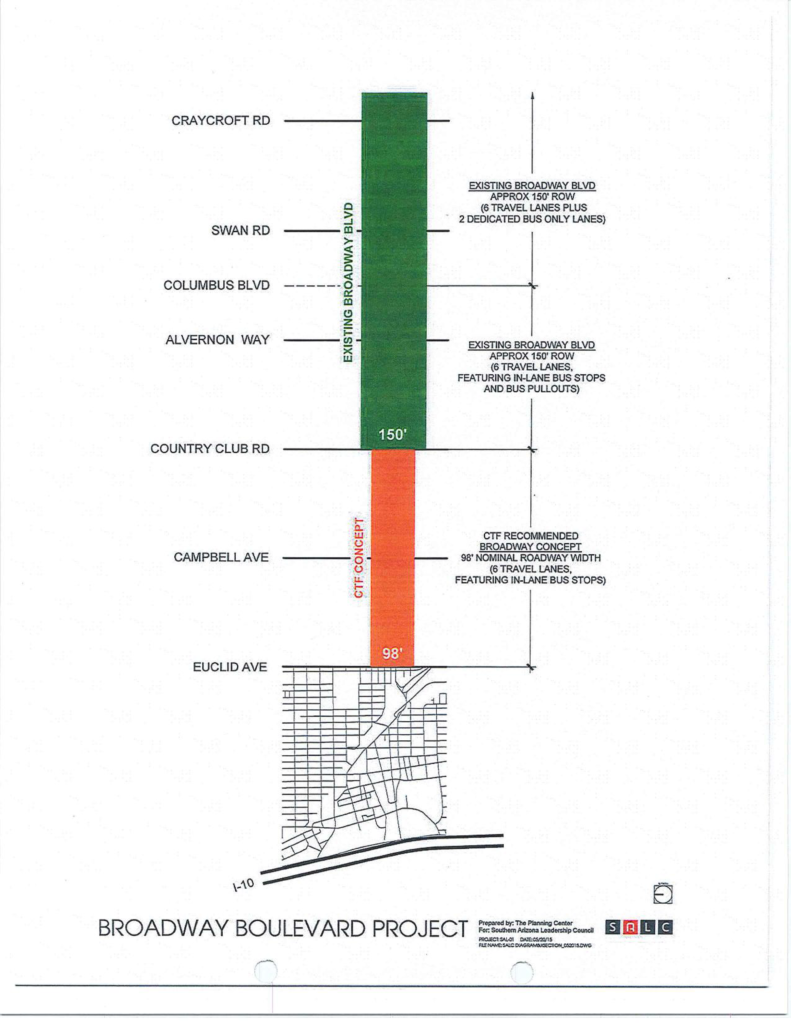Si Schorr: no further erosion of the 2006 voter-approved plan

The Tucson Mayor and Council is expected to approve the Citizen’s Task Force Recommended Technical Design Parameter and the Baseline Alignment Concept at its Tuesday, June 9, 2015 meeting. Complete agenda can be found here.
Op Ed written by Si Schorr first printed in the Arizona Daily Star and reprinted with permission follows:
In 2006, Pima County voters strongly approved a Regional Transportation Authority plan with 17 “Key Regional Corridors.” One would widen Broadway (for two miles from Country Club to Euclid) with six lanes, two bus lanes, bike lanes and other amenities with direct access to I-10 via the Links Project.
Much of Broadway east of Country Club has a nominal 150-foot cross-section with six lanes plus two bus lanes east of Columbus.
The RTA plan was developed by a regional 35-member Citizens Advisory and a 22-member Technical Management committee. The city of Tucson had been planning such expansion for decades and has now acquired approximately 25 percent of the right-of-way (expending about $6 million) toward this effort.
Last December, the RTA, prompted by neighbors in the project area, narrowed the voter-approved project to a nominal 120-foot cross-section, from eight to six lanes, by basically eliminating the two dedicated bus lanes. In February, the city staff proposed a modified alignment which, while reducing the footprint for these two miles, preserved many amenities of the voter-approved RTA plan.
Many responsible for the voter-approved plan have accepted this refinement to get construction, planned by 2016, finally underway.
However, this modified alignment is now threatened by further constriction. The city, in 2012, appointed a neighborhood 13-member Citizens Task Force (CTF). Its goal: minimize property acquisition and prevent demolition of what they define as “historical” structures. They now propose — once termed a “starting small” plan — to even further reduce the Broadway widening to a nominal 98 feet by reducing the width of landscaping, sidewalks and bike lanes, and reducing bus pullouts and dedicated bus lanes.

Such concepts were considered and rejected by the RTA Citizen Advisory and Technical Committees before the 2006 election.
The neighborhood CTF cites a few justifications for its proposal to essentially jettison the 2006 voter-approved plan for Broadway expansion and perpetuate the bottleneck to the now-thriving downtown. They include:
- Traffic
- — In spite of recent studies showing increased Broadway congestion, the neighbors maintain that Broadway traffic projections have and will continue to be “diminished” based upon studies, some of which occurred while the streetcar project diverted traffic from downtown.
- Sunshine Mile
- — The CTF/neighbors have also conjured the image of a revitalized “Sunshine Mile,” a long-forgotten brand that some merchants came up with in 1953. I have traveled Broadway for more than 50 years and until recently never heard this label used for this stretch.
- Destruction of historic and architecturally significant buildings
- — There are few such buildings in these two miles, other than Broadway Village and the Chase Bank Building, which are unaffected, and no historical structures. Indeed, travel down Broadway and you will see for yourself a “tired two-mile stretch of road,” as the Star’s Tim Steller wrote on May 10.
- The CTF/neighbors’ plan
- would also require full or partial property takings on not one, but on both sides of Broadway — paying more to get less — and create more uncertainty for business owners, many of whom, according to city surveys, want their property acquired right now.
The RTA rationale for a $42 million funding for this two-mile stretch is that Broadway is a “key regional corridor” — stress regional. The inordinate power given by government to a neighborhood group to, in essence, dramatically reduce and trump a voter-approved regional project is an abdication of responsibility with a deleterious effect on both regional planning and economic growth.
Moreover, what would amount to a 33 percent reduction in the planned two-mile cross-section diminishes both the “functionality” and “regional objectives” of the voter-approved plan for Broadway.
The city and the RTA should not allow any further erosion of the 2006 voter-approved plan. Rather, they should reject the CTF/neighbors’ proposal, embrace the recently modified staff plan (itself a compromise), and start toward construction of this regional project, which will serve as a fitting gateway to a rejuvenated downtown.
Si Schorr is a senior partner at Lewis Roca Rothgerber. He served as the first chairman of the Regional Transportation Authority and chairman of the Arizona State Transportation Board.